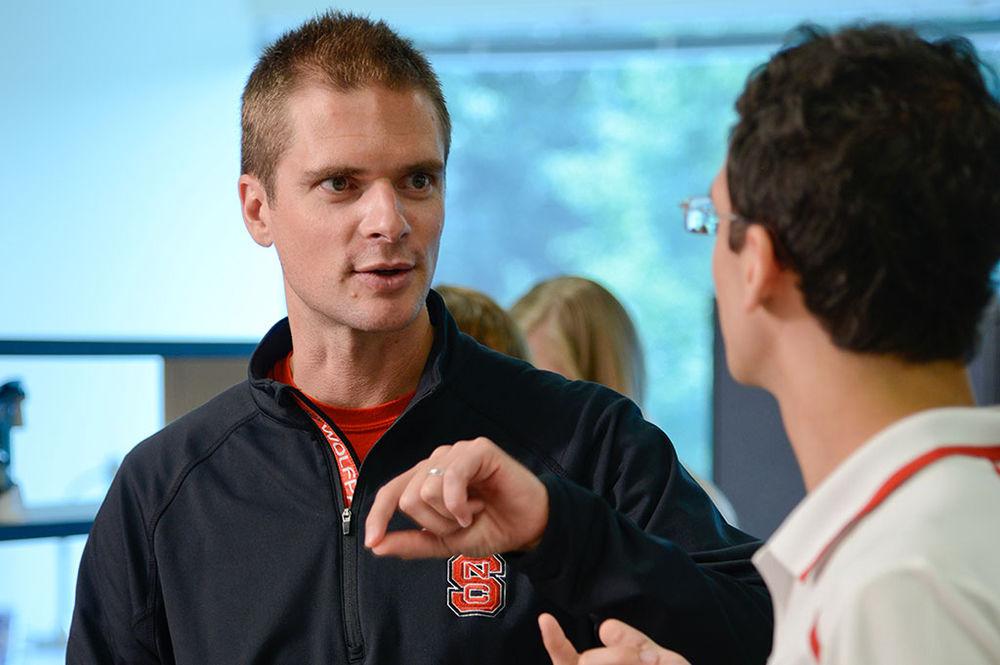Rodolphe Barrangou, an associate professor in NC State’s Department of Food, Bioprocessing and Nutrition Sciences, will be receiving the 2018 NAS Prize in Food and Agriculture Sciences for his work with Clustered Regularly Interspaced Short Palindromic Repeats (CRISPR).
The NAS prize is awarded to mid-career scientists who have made extraordinary research contributions to agriculture or food production. Barrangou’s work with CRISPR in bacteria has the potential for significant use in food and agriculture, such as virus resistance in yogurt and genome editing in livestock. Technician sat down with Barrangou to discuss his research, background and future.
What started your research with CRISPR?
I came across CRISPR by accident. I was sequencing genomes of bacteria a while back before CRISPR was notorious, let alone known, and you assemble genomes DNA elements that are repeated and difficult to assemble. It’s like assembling a puzzle. I came across CRISPR looking at genomes without knowing what it was or what it did and at the time the CRISPR acronym itself wasn’t even popular. My colleagues and I worked on CRISPR when it was still obscure and unknown.
Who worked with you on your research?
A number of people worked with me. At the time, I was at DuPont. I was working in a research development team in Madison, Wisconsin, America’s dairy-land, and we were working on the development of sericultures used in food manufacturing for the transformation of milk into cheese and yogurt. So there were hundreds of people working on it in the company and there were two certain teams working on CRISPR. One in Madison that I was managing and one in France my colleague and partner in crime, Philippe Horvath, was in charge of. For about a decade we worked together at DuPont on characterization of the biological function of CRISPR immune systems.
How long has this research been taking place?
First time I came across CRISPR was 2004. Our big claim to fame, and my big claim to fame, came about in 2007 when I and my colleagues published a paper unearthing what the actual function of CRISPR-CAS systems are. Between 2007 and 20ll, my collaborators and I worked together to figure the drive behind the CRISPR-Cas immune system. CRISPR acts a molecular scalpel to cut viral DNA when viruses inject their DNA into their bacterial host. The world of CRISPR changed in 2012 when Jennifer [a colleague] discovered you can take out the CRISPR molecular machine and turn it into a DNA cleaver tool and reprogram it to cut any DNA you want. That transformed CRISPR from a biological phenomenon into a tool. Within six months of that, other colleagues showed that you could use that scalpel to cut human DNA essentially editing, changed with the letters, of the DNA. You can rewrite the genome. At the same time in food and agricultural services, it’s the harnessing of this biological phenomenon in food manufacturing that helps. Without this technology, the manufacturing of dairy product, especially cheese, would not be the same globally as it is today.
Did you always know you wanted to be in food science?
Academically, it took me a while to find my way to food science. I used to be French, so I had a special relationship with food. I had wanted to do something biology and chemistry. I did my undergrad in chemistry and my master’s in biological and chemical engineering. Then in the late 90s I emigrated away from France to come to NC State of all places and did a master’s in food science, which is where I discovered food microbiology. I stayed on to do my Ph.D. in genomics. Working up in Wisconsin for ten years is where I found my passion for dairy and continued working on probiotics. I like the pace of the food world. I think over time, people have a better appreciation of how the diet shapes a person’s health and do not necessarily need drugs to promote health. You can use functional foods. So coming up with flavorful, enjoyable, sustainable and safe foods is a great field to be in. We need this technology to help bridge the food gap between people.
What do you teach at NC State?
I teach an Introduction to Biopharmaceutical Science and Advanced Food Fermentation currently. In addition of my teaching duties, my primary appointment is in research so I supervise and mentor, in the terms of teaching, a number of graduate students, postdocs, and staff in the labs. I have about twelve people right now at CRISPR lab performing research so I teach and mentor them on a more individual basis.
What are your plans for the future?
It is amazing to see the pace the past five years of the CRISPR craze, to see the speed in which the technology is being released over a range of fields. You can cure human disease with gene therapies. You can generate next generation crops in non-GMO ways. You can raise animals better and faster than ever. One of the reasons I love being involved with NC State is because I can be involved with a number of companies. I have been involved with three different start-up companies in the last five years that are all doing amazing things. One is Caribou Biosciences on the west coast who are developing technologies that are CRISPR-based. I am also involved with Intellia Therapeutics. I got to ring the bell of the NASDAQ for them. And last but not least, there is Locus Biosciences which uses CRISPR as a microbial and sequence-specific antibiotic. It is moving on extremely well, and we have hired a number of NC State alums.








